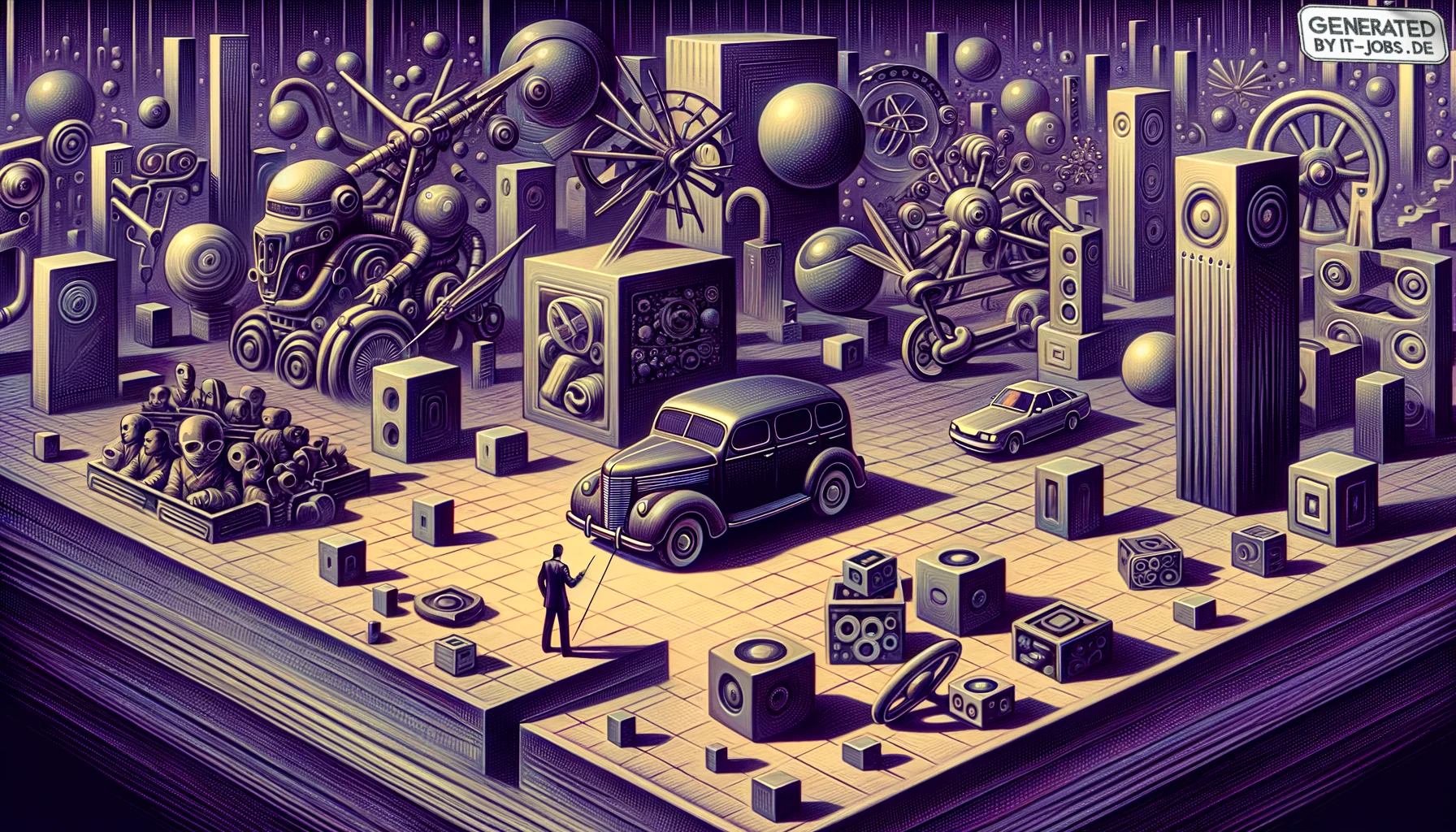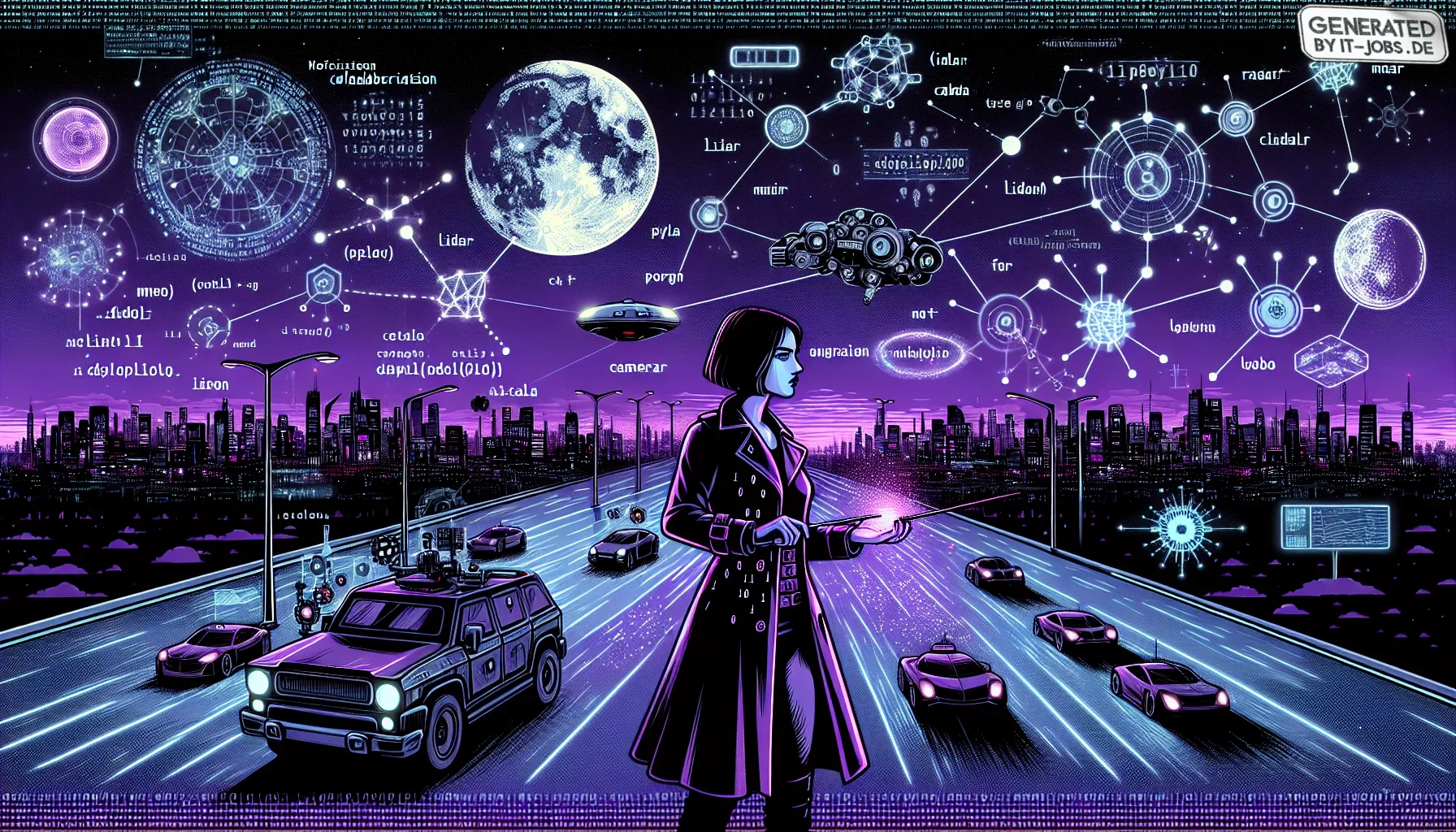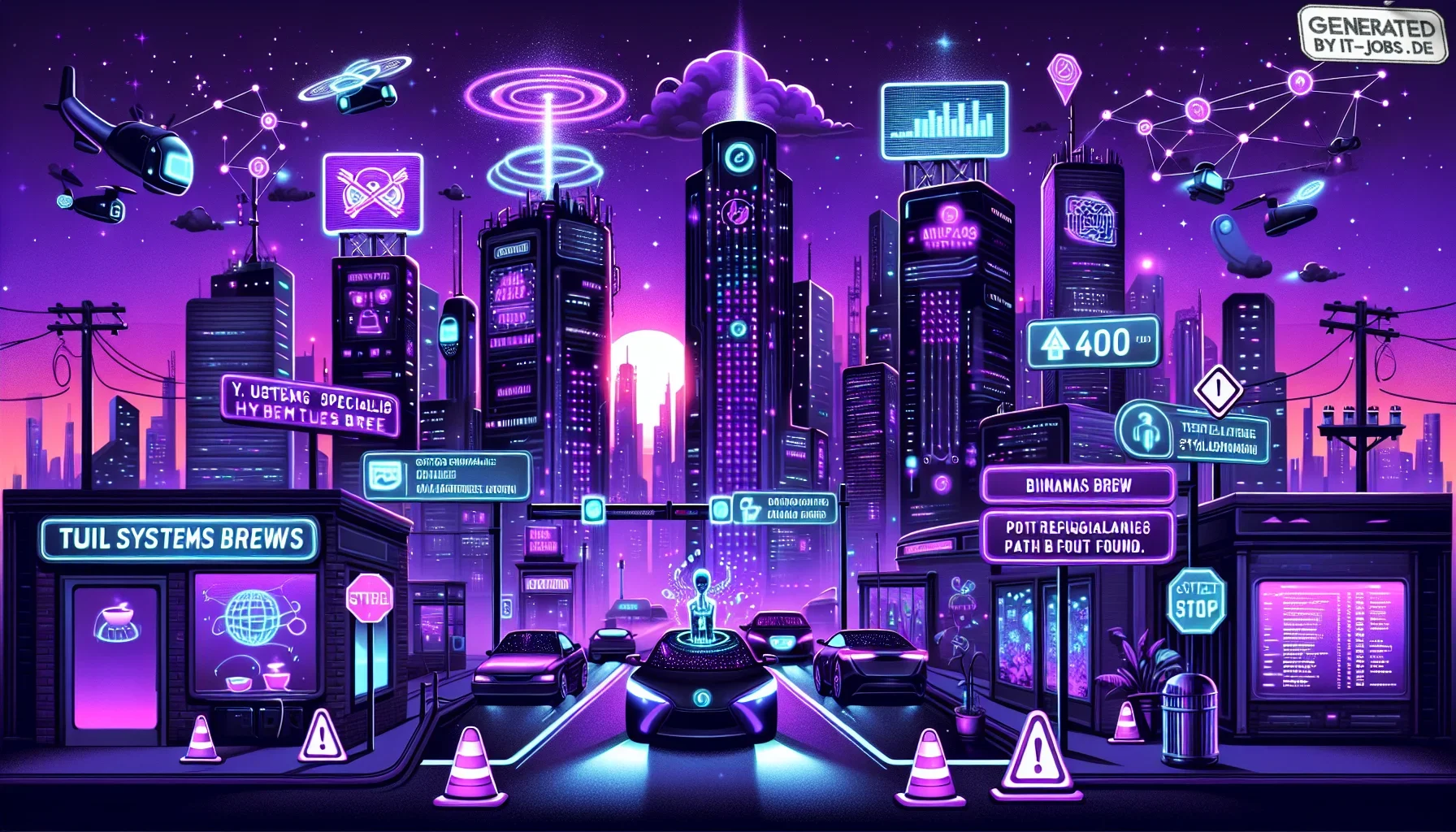
What Does an Autonomous Vehicle Systems Specialist Do?
"To err is human, but to really mess things up you need an autonomous vehicle system."
- The Rise of Autonomous Vehicles: A Primer
- The Role of an Autonomous Vehicle Systems Specialist
- Engineering Challenges and Innovations
- Safety, Testing, and Evaluation
- The Importance of Data and Machine Learning
- Skills and Qualifications for Aspiring AV Specialists
- Regulatory and Industry Challenges
- Navigating Regulatory Landscapes
- Liability and Insurance Models
- Building Public Trust and Acceptance
- The Future of Autonomous Vehicles in Urban Landscapes
- Conclusion and Looking Ahead
- References
The Rise of Autonomous Vehicles: A Primer
In a world where technology sculpts our daily lives, autonomous vehicles (AVs) have driven straight out of sci-fi fantasies and into the fleets of today's IT professionals. These sophisticated marvels are more than just pieces of high-tech wizardry; they promise to reshape our infrastructure, redefine urban planning, ignite the passions of tech enthusiasts, and bring a whole new dimension to what driving means—minus the driving part. If the Jetsons had a family road trip in one of these, they might just nod in agreement with how far we've come from imagining to implementing automation.
From the early tinkering days of the 1920s' "phantom autos" to the modern marvels tooling around our cities today, the evolution of autonomous vehicles reads like a gripping novel with compelling twists and turns. These 'phantom autos' were fascinating pioneers that paved the road for today's vehicular brilliance, and now, decades later, we stand on the precipice of a market ready to hit $615 billion by 2026, according to potent insights from the Journal of Big Data (2023). It seems we're teetering on the edge of an automotive renaissance, and for once, you might just want to give in to cars that say, "Understood, I’ll take it from here."
Understanding Autonomous Vehicles
The unbridled magic of autonomous vehicles lies in their ability to sense, adapt, and navigate the world without relying on human hubbub. They come in various forms and flavors—ranging from those futuristic juggernauts with full autonomy (taming roads with no human interaction) to semi-autonomous stalwarts that occasionally beep back, "Hello there, I'm still working here." The development of these wondrous vehicles is an expansive buffet teeming with techno-delights, attracting automaking behemoths alongside nimble startups both laser-focused on transporting this technology into the everyday.
The full-blown sci-fi dream of Level 5 AVs—a seamless handover of all driving duties to the vehicle—remains tantalizingly close in sight, much like that elusive software update that promises endless possibilities. As it stands, our roads are home mostly to Level 2 and 3 AVs, a landscape enriched by partial autonomy, fusing cruise control and lane-keeping prowess. With every byte of code and every testing mile garnered, we inch closer to mitigating human-dominated blunders—an era where "oops" will mostly belong to the vocabulary of history textbooks.
Key Technological Innovations
Enter the secrets in the sauce for these cutting-edge vehicles: a symphony of sensors—LiDAR, radar, and cameras—acting as all-seeing eyes on wheels hyper-aware of their surroundings. These impressive gadgets craft a comprehensive 360-degree view, coaxing data into understanding and scouting the road, while instilling a confidence that makes any seasoned driver envious.
But knowing isn't enough—these road-savvy systems depend on the linchpin of onboard computing. This is where artificial intelligence, our contemporary maestro, deftly orchestrates actions from raw insights. Thanks to significant strides in AI and machine learning, vehicles increasingly emulate remarkable human-like judgement, learning one tricky roundabout at a time. Sifting through nuances and embracing novel adaptations, these algorithms continue to refine decision-making prowess, sketching the next idyllic chapters for driverless exploration.
Levels of Automation
Stepping up to the podium, the Society of Automotive Engineers (SAE) unwinds the mysterious lexicon behind AV technology with their levels of driving automation. From a bare-boned Level 0—essentially a vehicular nod to Fred Flintstone’s foot-powered model—to the full elegance and opulence of Level 5 where cars beguile with 'chauffeur' finesse, this spectrum is studded with pivotal advancements.
Today, the AV circuitry is buzzing with Level 2 and 3 vehicles, wielding partial automation with an edge in advanced driver-assistance systems (ADAS). Marvel at the magic—Tesla's Autopilot or GM's Super Cruise—which stitches together adaptive cruise control with lane-centering brilliance. Level 3 inhabitants even afford drivers the luxury of technological respite, although remaining alert and ready to resume command remains a trusty requirement.
With McKinsey's 2023 predictions as our compass, the horizon shows Level 4 AVs autonomously zipping through standard byways by 2030. While Level 5 realities remain a riveting aspiration, the ambitious endeavors to traverse unmapped terrains promise an exhilarating journey—an adventure punctuated by technology and the once-in-a-lifetime opportunity to call the shots—without really having to.
The Role of an Autonomous Vehicle Systems Specialist
Picture this: an autonomous vehicle cruising smoothly along a scenic highway, its occupant relaxed and perhaps sipping on a latte, while, theoretically, nothing could go wrong—unless of course, the vehicle decides to spontaneously audition for a sci-fi thriller. Here's where our unsung hero steps in—the Autonomous Vehicle Systems Specialist. These tech magicians are the brains behind the operation, ensuring that AVs are more 'Driving Miss Daisy' and less 'Mad Max,' diligently working their techno-spells behind the scenes. They're neither clad in superhero capes nor dotted i's, yet their expertise keeps the AV sphere spinning calmly on its axis.
Think of these specialists as the pit crew of an F1 team, but substitute the wrenches for algorithms and the tires for terabytes of data. They navigate a labyrinth of intricate technology—sensor systems like LiDAR, radar, and onboard computing, merging them with artificial intelligence to bring vehicles to 'life,' without them calling it quits halfway across the I-95. The art of blending sophisticated tech seamlessly into a self-driven odyssey is akin to perfecting an intricate symphony; the specialists are the conductors who ensure every note hits just right.
Their realm isn't confined to just installing and tinkering with systems; these specialists shoulder the immense responsibility of troubleshooting technical intricacies and aligning their work with evolving regulatory landscapes, all while managing real-world deployments and iterative improvements. With a knack akin to that of chess grandmasters, they anticipate gambits like your neighbor's kid's bicycle veering onto the road or roadworks popping up like an unexpected plot twist. It's all in a day’s work, wrapped up with a measuring tape's precision and a wizard’s foresight.
While AI feeds the core of autonomous vehicles, AV Systems Specialists serve as the intuitive bridge between silicon logic and the unpredictable human element. It's a role that requires not only engineering expertise and programming prowess but also a flair for deciphering cyber-security riddles. Yes, they also double as diplomats; nurturing smooth cooperation between the robotic cog and human concerns calls for patience and interpretative dexterity rivalled only by ancient rune readers.
Engineering Challenges and Innovations
Being at the vanguard of innovation isn't a leisurely cruise; rather, it's often a challenging odyssey with potholes along the route. AV Systems Specialists face enigmatic engineering conundrums, with resilience and adaptability being their chariots in a landscape where environments shift unpredictably and passenger safety is non-negotiable. If the passengers yearn for an experience reminiscent of a serene yacht ride, the specialists need to sculpt systems that are equally durable and delicate. Exploring breakthroughs in AI and machine learning, they shape tomorrow's transportation systems, ensuring they don’t steer off track, metaphorically or otherwise.
Safety, Testing, and Evaluation
Consider safety as the north star in the AV galaxy—a constant guiding presence upon which the technology's compass rests. When it comes to AV Systems Specialists, safety isn't just an objective; it's an obsession. Through rigorous testing protocols, specialists orchestrate elaborate dress rehearsals featuring virtual simulations that wouldn't look out of place in a futuristic film fest. These digital arenas bring heuristic road narratives to life without flustering real-world traffic patterns or tethering development with regulatory tripwires. Navigating compliance is a relentless engagement, where specialists dodge evolving guidelines to ensure progress doesn’t stall like a fickle carburettor on a wintry morning.
The Importance of Data and Machine Learning
Now, let's talk alchemy. In the realm of AV Systems Specialists, data is as precious as gold, only less shiny and more sufficient in glitter. They extract vast data reservoirs pouring in from vehicle sensors, manipulate it through the crucible of machine learning, and transmute it into luminous insights. These skilled virtuosos sift, sort, and sequence information streams to sharpen systems’ decision-making powers, ensuring vehicles don’t take architectural framing cues from hedges or traffic pylons. Their work transforms raw mileage into a wise old sage, guiding AI systems along roads paved with not-so-gold wisdom.

Skills and Qualifications for Aspiring AV Specialists
So, you're ready to set sail on the adventurous sea of autonomous vehicle systems? Well, strap in, dear traveler, because the journey to becoming an autonomous vehicle systems specialist demands more than just a knack for untangling wires or a talent for decoding binary systems without even pausing to sip your coffee. This is a dynamic expedition, requiring a symphony of technical expertise and interpersonal finesse that will keep you pacing ahead of the competition.
Technical Skillsets
In the electrifying realm of autonomous vehicles (AVs), your technical acumen will undoubtedly serve as your primary toolkit. Mastery over programming languages such as Python, C++, and MATLAB is your compass and map—essential for developing and simulating the sophisticated algorithms that drive the brains of these futuristic vehicles. While coding forms the backbone, a strong grasp of systems engineering is crucial for understanding and orchestrating the complex dance between various vehicle components—think of yourself as the conductor of a high-tech orchestra composed of sensors and actuators. You'll also need to have an exceptional understanding of sensor technologies, including LiDAR, radar, and cameras, which serve as the vehicle's sensory organs, helping it tread along its path with precision.
What truly distinguishes an AV specialist is the ability to integrate these individual skills into a well-oiled machine. This frequently requires utilizing platforms such as ROS (Robot Operating System) to develop and manage robotic software. As if that isn't thrilling enough, the fields of machine learning and artificial intelligence also present exciting opportunities for enhancing the intelligence and responsiveness of AVs, making a solid understanding of these areas even more critical. Within the static universe of certifications, staying up to date is pivotal—explore specialized credentials like SAE's AV Certifications or indulge in comprehensive professional workshops to keep your intellectual engine purring smoothly.
Soft Skills and Problem-Solving
Imagine soft skills as the lubricant keeping the intricate machinery of your career as an AV Systems Specialist running smoothly. Communication and teamwork aren't just nice-to-haves in this multidisciplinary domain—they're your bread and butter. Specialists often collaborate with a plethora of teams, ranging from software wizards and hardware champions to data alchemists, while also maintaining a dialogue with regulatory bodies and stakeholders. Conveying complex technical ideas in a way that makes sense to someone who sees binary as just a series of 0s and 1s is as crucial as realizing your morning latte needs a tad more vanilla syrup. But communication is only part of the equation; it's about absorbing diverse insights and turning them into constructive solutions.
Then there's problem-solving—consider it the turbocharger for your career. Every mile an autonomous vehicle travels brings forth a unique challenge, from interpreting complex traffic patterns to dealing with spontaneous system hiccups. Your ability to innovate and adapt instantaneously, like solving a roadside puzzle, is what defines your credibility in this arena. And let's not forget—emotional intelligence, adaptability, and a hunger for continual learning are your covert superpowers here. In a rapidly changing AV landscape, maintaining an open mindset, an ability to pivot strategies, and a commitment to never rest on your laurels ensure you're not only equipped for today's obstacles but are also poised for tomorrow's uncharted territories.
Regulatory and Industry Challenges
While the technical rollercoaster bolsters the thrilling development of autonomous vehicles, let’s not glide past the battleground of regulatory and industry challenges. Picture the AV sphere as the ultimate ninja warrior course, demanding acrobatics not just in technology, but also in legal and policy hurdles. Each nation, in a bid to navigate the AV terrain, crafts its roadmap peppered with "keep out" signs and "proceed with caution" signals.
Globally, we're talking about more than 50 countries knitting a patchwork of AV regulations, seen as both a golden opportunity and a thorny path filled with potential pitfalls for aspiring AV innovators. The vision is clear: a world where cars don't just accompany us but autonomously escort us through our daily escapades. However, before we can bask in this utopian experience, there’s a gauntlet of legalities to wrestle with.
Whether we’re zooming across the European Union's hopeful unified framework aiming to unsnarl disparate national policies, or navigating the U.S. kaleidoscope of state-specific laws, it’s a mixed bag of encouragement and handicaps. Germany, for instance, dashed off the start line to legalize Level 4 autonomy, whereas the U.S. continues to stitch together a Frankenstein-esque regulatory landscape from 38 varieties of state law fabrics. This regulatory hodgepodge simultaneously fans the flames of innovation while occasionally suffocating it with inconsistencies.
Navigating Regulatory Landscapes
Imagine trying to complete a thousand-piece puzzle, but every region uses its piece shapes. Welcome to the current state of AV regulations. The European Union is marching towards standardization with an ambitious framework slated for 2026—a bold move to simplify international scalability. Compare this to the U.S. jigsaw, where 38 states dance to their legislative drummers, turning regulatory uniformity dreams into a chaotic cat-herding venture—albeit, very intelligent and wise cats!
Across the Great Wall lies China's AV saga, a narrative of streamlined regulatory gallantry. From ascending the AV trials front-runner throne to welcoming Level 4 autonomy with open city arms, China exemplifies a red-carpet approach to regulation. This strategic narrative extends into APAC regions where smart cities are beginning to blossom under AV-friendly skies.
Navigating these regulatory labyrinths demands AV developers to be as adaptable as their technologically-advanced creations—forming strategic alliances, and engaging with local governments, all while playing a diplomatic symphony in the legislative corridors of AV dominance.
Liability and Insurance Models
In this brave new world of autonomy, the liability baton is passed from individual drivers to manufacturers, turning the traditional blame game into a high-stakes legal waltz. Imagine the collective relief when manufacturers bypass the thrill of guessing who’s behind the wheel in an AV blunder, only to face the sober reality of dissecting algorithms and software glitches.
Insurance companies now face the monumental challenge of redesigning models to mirror this responsibility shift, crafting solutions to hold manufacturers accountable in the AutoMusk-ed realm. Germany's progress is noteworthy, where robust insurance frameworks dare to peek at what’s behind the proverbial AV curtain, ensuring accountability in Level 4 autonomy roads.
Building Public Trust and Acceptance
Introducing autonomous vehicles to a skeptical, often techno-wary public is akin to convincing a cat it's okay to take a bath—it’s an art of gradual acclimatization. Winning hearts and minds extends beyond regulatory handshakes into the fundamental realm of trust and cultural acceptance.
With strategies rooted in real-world engagements, companies deploying pilot projects have found success through unfiltered transparency and engagement. Initiatives by industry leaders like Volkswagen and Uber serve as mighty blueprints, offering flightless birds a glimpse of flight—by actually letting them soar in AV test rides.
Clearing the fog of skepticism requires unboxing the genie of AV tech—generously offering insights on safety, precision, and reliability to an inquisitive public. In essence, establishing acceptance is not just about integrating AVs into urban jungles, but weaving them gently into the cultural fabric of everyday living. With a thoughtful education process, proactive engagement, and the consistent backing of regulatory progress, the journey from novelty to necessity is one we are poised to traverse.
The Future of Autonomous Vehicles in Urban Landscapes
Welcome to the brave new world where buses are driverless, traffic lights have become optional, and your car is more likely to question your choice of route than your spouse! As autonomous vehicles (AVs) cruise down the lanes of tomorrow and redefine urban utopias, let's delve into how they're reshaping our cities. From the transformation of infrastructure to shifts in urban planning and the dawn of greener living, AVs promise to usher us into a smarter, cleaner future, without turning the road into a chaos-filled obstacle course—at least, we hope.
AV Integration in Smart Cities
Imagine a city where your car knows what you need before you do—a place where vehicles communicate seamlessly to reduce congestion and emissions with the precision of synchronized swimmers. Enter the domain of AV integration in smart cities.
Smart cities have moved beyond being playgrounds for science fiction enthusiasts; they're swiftly becoming reality as tech aficionados, urban planners, and environmentalists craft a utopian vision to meet the modern urban population's demands. These advanced urban centers are embracing AVs as key elements rather than peripheral components. By leveraging IoT networks, they allow vehicles to share real-time data with city infrastructure, optimizing everything from traffic flow to energy consumption.
Consider Singapore, where autonomous shuttles are testing the waters in smart city trials. Picture a commute where your AV drops you off precisely when and where your coffee is at its freshest, thanks to real-time data—like AI's version of your grandmother intuitively sending cookies. AVs within smart cities promise fewer private cars on the road, creating more pedestrian-friendly areas and cultivating a symbiosis between transit systems and urban landscapes that redefine commuting. But as incredible as these benefits sound, integrating AVs into smart cities is no walk in the park; think more along the lines of a marathon through policy revisions, infrastructure changes, public acceptance strategies, and, occasionally, negotiating with rebellious pigeons.
Success Stories and Lessons Learned
Gently nudging aside the skeptics who see AVs as headline-grabbing disasters waiting to happen, several cities have flipped the script by transforming AVs from theoretical novelties into practical success stories. In cities like Boston or Pittsburgh in the USA, autonomous vehicles are enriching public transport networks not just by getting people from A to B without detours through C but by accentuating accessibility, safety, and overall transit joy.
In Boston, driverless cars have received grants to explore integrated schemes connecting with the current transit infrastructure. The formula for success isn’t solely technological prowess; it relies heavily on collaboration among municipalities, tech companies, and the public—a crucial lesson for any city diving into AV integration. Internationally, Helsinki's experiment with robo-buses displays how AVs can shift public transport from being accident-prone to a model of reliability.
These examples underscore valuable insights: collaboration can't be skipped, involving communities and policymakers frequently, leading to refined regulations and implementation strategies. Additionally, dedicated infrastructure and a patient, phased approach work wonders far better than rushed deployment. Lessons from these cities advocate for transparency in trials, setting realistic goals, and involving local expertise, which helps turn idealistic concepts into practical realities without causing any mayhem.
Innovating for Sustainability
The ultimate aha moment in autonomous vehicle development is their potential to champion sustainability beyond industry animators’ dreams. In the shift toward greener urban landscapes, AVs are carving out a niche as unexpected heroes. Pair autonomy with electric power, and a surprising alliance emerges to navigate the road toward a sustainable future.
AVs add layers to this narrative by significantly reducing emissions. Studies propose that AVs could curtail carbon emissions by over 80% when employed as electric shared models, thanks to their optimized driving patterns and minimal idle times. Beyond this, AVs promise innovation through smart routing, maintaining free-flowing traffic, saving valuable time, and reducing pollution—a win for both nature and road rage management.
Nonetheless, being the eco-friendly lead isn’t without its quirks and demands. From the requirement for comprehensive charging infrastructures to redesigned roads favoring AVs, substantial groundwork investment is essential. Yet, envision this not as rewriting an entire system but more akin to launching the best new era of urban life, complete with harmonious narrative arcs.
These sustainability initiatives revolve around centers of viable policies and economic innovation. AVs are anticipated to foster vehicle-sharing platforms drastically lowering urban car densities—introducing more green spaces, parks, and avenues that promise both tranquility and seamless travel, similar to that exquisite morning espresso that kickstarts the day. AVs aren’t merely transport machines; when coupled with renewable energy, they hold the promise to redefine urban sustainability and partake in orchestrating the monumental transport revolution within cityscapes.

Conclusion and Looking Ahead
As our autonomous odyssey draws to a delightfully caffeinated close, it's evident that we're steering into a future where human hands are preoccupied with holding steaming lattes instead of steering wheels. The journey of autonomous vehicles (AVs) isn't merely a quest for cutting-edge technology but rather a fundamental shift in how we experience mobility and engage with the urban tapestry. This journey encompasses more than just transportation—it's a multifaceted revolution with profound societal, economic, and environmental implications that promise to redefine the modern world.
The autonomous vehicle systems specialist stands as a pivotal figure in this transformation. These specialists, the unsung heroes of the AV realm, adeptly navigate the intricate labyrinth of sensors, algorithms, and data. They're like the tech world's equivalent of rock stars, strumming the electric heartstrings of AV innovation. Specialists are integral in shaping the ethical, safety, and regulatory frameworks essential for public trust. As they continue to drive the innovation torch forward, they ensure technology remains true to its purpose: enhancing human life without compromise.
Looking ahead, the road is paved with both traffic cones and opportunities. AV technology holds the transformative potential to reshape urban infrastructure and usher in new paradigms for smart cities, where efficiency and sustainability become staples rather than anomalies. Imagine cities where the cacophony of rush hour honking is replaced by the gentle hum of synchrony, where mobility transcends being a mere necessity and evolves into an equitable right accessible to all.
Of course, this journey isn't without its share of potholes. From navigating the regulatory mazes to tackling liability puzzles and bridging the gap with public perception, daunting challenges abound. Yet, it's by embracing these challenges, engaging in earnest dialogue, and spearheading innovation that the true potential of AVs will be realized. When aligned with global sustainability goals, AVs can redefine intelligent transport solutions and set new benchmarks for the industry.
As we glimpse the sparkling future of mobility on the horizon, it's refreshing to realize that we're not just passive passengers but active navigators alongside these technological marvels. Through continued collaboration, ingenuity, and foresight, AVs inch closer to transforming our daydreams of a safer, more connected, and resilient transport ecosystem into reality. So, here's to the thrilling road ahead—one that's as much about the transformative journey as it is about the exhilarating destination.
References
As we've navigated through the dynamic landscape of autonomous vehicles, it became abundantly clear that our journey wasn't traversed on intuition alone—it was firmly grounded in the wealth of information compiled from meticulous research, insightful industry perspectives, and rigorous academic discourse. These references act as our trusty map and compass in a sometimes bewildering terrain.
Throughout the blog post, we've relied on a diverse array of reliable sources to crack open the hood and dive deep into subjects ranging from historical progress in AV technology to the nitty-gritty of regulatory frameworks. The following are the key references employed to enrich our exploration:
- Exploration of Issues, Challenges, and Latest Developments in Autonomous Cars - Journal of Big Data: Written by B. Padmaja and collaborators, this exhaustive review sets the stage for understanding both the grand and granular aspects of AV systems. With a spotlight on the sophisticated architecture and the cunning use of machine learning, this paper becomes a compass for those venturing through the AV jungle. You can check it out here.
- Innoviz Technologies - Autonomous Vehicle Trends 2025: This enlightening piece zeroes in on sensor resolutions and emphasizes the increasing need for high-bandwidth data systems. It's a treasure trove of insights for those curious about the frontier of AV tech. To dive into the details, explore more.
- Regulations for Autonomous Vehicles: Where Do Countries Stand in 2024-2030? - PatentPC Blog: Written by Bao Tran, this article offers a panoramic view of the regulatory landscapes in various countries, shedding light on the policy arrows shaping the AV future. For those who fancy a regulatory roadmap, you can read the full article.
- NHTSA Unveils New Autonomous Vehicle Regulations - Repairer Driven News: Dive into the U.S. legislative jungle with this piece that discusses the efforts to harmonize AV laws, preventing state-by-state regulation chaos. A must-read for anyone fascinated by policy harmonization. Find more details here.
These selected works serve as the backbone of the intricate knowledge framework we've built in this blog post. They don't just open doors but roll out the red carpet for anyone eager to explore the intricate and electrifying dimension of autonomous vehicle systems. Whether you're an aspiring AV enthusiast or an experienced industry professional, these resources provide the GPS to guide you through the future trajectories of this groundbreaking field.







